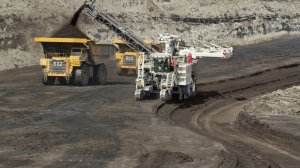Surface miners to take over mining landscape in South Africa


MODERNISING OPENCAST MINING Wirtgen surface miners offer an alternative mining approach that will benefit the South African coal mining industry
Mining solutions provider Wirtgen South Africa (SA) is engaged in extensive talks with various mining companies about solutions for their greenfield and existing mines. Surface miners are set to change the opencast mining industry in South Africa, as they have done worldwide, by addressing the need for safer, more environment-friendly, effective and efficient mining, states Wirtgen SA business development manager Calvin Fennell.
Several field tests conducted at mine sites in South Africa have confirmed that Wirtgen’s surface miners offer significant advantages over traditional opencast mining methods used by the local industry, especially for coal mining.
Wirtgen surface miners are crawler-mounted mining machines with a rotating drum for rock penetration mounted at the centre of gravity. This configuration ensures that the full weight of the miner can be transformed into rock-penetration force. The rotating cutting drum cuts the material out of the ground, rather than the material being blasted. The drum transfers the material onto a conveyor belt, from which it is directly loaded onto a dump truck.
While there are more than 600 of these surface miners operating worldwide, Wirtgen SA sales consultant Mike Newby notes that their introduction to South Africa has been slow, owing to a hesitancy from local mines to abandon more traditional mining methods such as blasting, drilling, truck and shovelling.
“The real challenge is getting companies that have been mining for several years to change their mindset. Many mines made it clear that they would not be willing to invest in a new machine unless they had trialled its performance at one of their own mines,” he says.
Wirtgen, subsequently, made a machine available specifically for such purposes in February, confirming that the surface miner offers significant advantages over traditional opencast mining methods and equipment. The machine was trialled on coal and interburden such as sandstone and mudstone on mines in Mpumalanga. Newby notes that this has been a very successful approach, as the company is now on the brink of securing supply and service contracts for South African mines.
Multiple Benefits
Newby explains that the key benefit of the surface miner is that it allows for highly selective mining. For example, when coal is mined using traditional drilling and blasting methods, and equipment, such as bucket excavators, the yield that is sent to the processing plant contains layers of coal and other contaminating materials such as sandstone and shale.
Separating the coal from the waste material to improve the quality of the yield is a challenge for many mines. However, with Wirtgen’s surface miners, even a thin seam of mineral material can be mined and precisely separated from the layers of contaminating material above and below it. Yields of uncontaminated coal can, thus, be produced using a more cost-effective and more environmentally sensitive approach than that of traditional mining methods.
Fennell highlights that this precision decreases the amount of fines produced during mining. The surface miners also employ fewer process steps than traditional mining, which reduces the amount of accidental breakage of mineral material. The amount of fines generated when rehandling the material during loading, transportation, stockpiling, sizing and washing is also greatly improved, compared with traditional mining.
“There are a number of challenges associated with failing to reduce the amount of fines that are generated when handling mined material. The cost of washing coal fines is higher because of the intensive processes used and the product losses that occur, all resulting in a lower rate of recovery. With increased losses, more tailings must be suitably disposed of and coal that does not meet the customer’s size requirements cannot be sold. Further, coal fines have the tendency to retain moisture, which can cause problems in downstream processes,” explains Fennell.
However, reducing fines content and the contamination of run-of-mine coal offers numerous advantages, such as a lower level of respirable and airborne dust, increased workplace safety, reduced risk of coal dust explosions and improved yields, he points out.
Field tests conducted by Wirtgen at eight pits worldwide have proven that the company’s surface miner can produce more than 70% target-size coal, while dozers employing the conventional rip-and-stack method produce about 58%. The surface miners, moreover, produce up to 33% less fine material than the dozers.
Newby also points out that the machines eliminate the need for drilling, blasting, loading and primary crushing equipment, which results in significant cost reductions while improving the quality and amount of coal in each yield. He highlights that the surface miners also improve safety at mines by eliminating the hazards associated with blasting, making them particularly useful when mining areas that are in close proximity to communities.
With mines globally under pressure to reduce costs and improve productivity while adhering to increasingly stricter environmental regulations, Newby emphasises that many companies are seeing the benefit of investing in Wirtgen’s surface miners. He notes that the machines are particularly well suited to South African coal mines that supply State-owned power utility Eskom, as they can ensure the supply of a consistent coal quality.
“With these machines, mines can selectively mine out the coal and blend it as they need, providing Eskom with a constant coal quality, stabilising the price they receive for this material. Coal quality can also be improved to meet export standards,” Newby says.
Comments
Press Office
Announcements
What's On
Subscribe to improve your user experience...
Option 1 (equivalent of R125 a month):
Receive a weekly copy of Creamer Media's Engineering News & Mining Weekly magazine
(print copy for those in South Africa and e-magazine for those outside of South Africa)
Receive daily email newsletters
Access to full search results
Access archive of magazine back copies
Access to Projects in Progress
Access to ONE Research Report of your choice in PDF format
Option 2 (equivalent of R375 a month):
All benefits from Option 1
PLUS
Access to Creamer Media's Research Channel Africa for ALL Research Reports, in PDF format, on various industrial and mining sectors
including Electricity; Water; Energy Transition; Hydrogen; Roads, Rail and Ports; Coal; Gold; Platinum; Battery Metals; etc.
Already a subscriber?
Forgotten your password?
Receive weekly copy of Creamer Media's Engineering News & Mining Weekly magazine (print copy for those in South Africa and e-magazine for those outside of South Africa)
➕
Recieve daily email newsletters
➕
Access to full search results
➕
Access archive of magazine back copies
➕
Access to Projects in Progress
➕
Access to ONE Research Report of your choice in PDF format
RESEARCH CHANNEL AFRICA
R4500 (equivalent of R375 a month)
SUBSCRIBEAll benefits from Option 1
➕
Access to Creamer Media's Research Channel Africa for ALL Research Reports on various industrial and mining sectors, in PDF format, including on:
Electricity
➕
Water
➕
Energy Transition
➕
Hydrogen
➕
Roads, Rail and Ports
➕
Coal
➕
Gold
➕
Platinum
➕
Battery Metals
➕
etc.
Receive all benefits from Option 1 or Option 2 delivered to numerous people at your company
➕
Multiple User names and Passwords for simultaneous log-ins
➕
Intranet integration access to all in your organisation



















